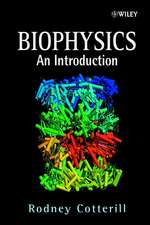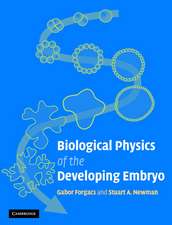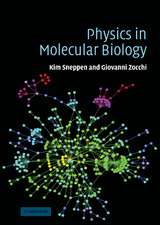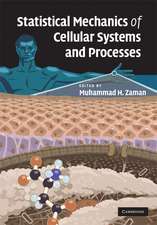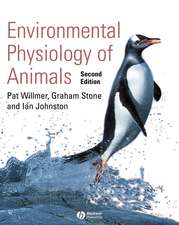Invertebrate Oxygen Carriers
Editat de Bernt Linzenen Limba Engleză Paperback – 30 sep 1986
Preț: 406.25 lei
Nou
Puncte Express: 609
Preț estimativ în valută:
77.74€ • 80.67$ • 64.98£
77.74€ • 80.67$ • 64.98£
Carte tipărită la comandă
Livrare economică 17-31 martie
Preluare comenzi: 021 569.72.76
Specificații
ISBN-13: 9783540169437
ISBN-10: 3540169431
Pagini: 536
Ilustrații: XIV, 521 p. 252 illus.
Greutate: 0.84 kg
Ediția:Softcover reprint of the original 1st ed. 1986
Editura: Springer Berlin, Heidelberg
Colecția Springer
Locul publicării:Berlin, Heidelberg, Germany
ISBN-10: 3540169431
Pagini: 536
Ilustrații: XIV, 521 p. 252 illus.
Greutate: 0.84 kg
Ediția:Softcover reprint of the original 1st ed. 1986
Editura: Springer Berlin, Heidelberg
Colecția Springer
Locul publicării:Berlin, Heidelberg, Germany
Public țintă
ResearchCuprins
Opening Session.- Homage to René Lontie.- Hemerythrins.- Structure, function and oxidation levels of hemerythrin.- Structure and Function of Invertebrate Hemoglobins.- The dissociation of the extracellular hemoglobin of Lumbricus terrestris: A model of its subunit structure.- Subunit structure of earthworm erythrocruorin.- Characterization of trimeric hemoglobin component from the earthworm, Lumbricus terrestris.- The structure of the extracellular hemoglobin of annelids.- Ophelia bicornis erythrocruorin. Some peculiar features.- Structure of annelid hemoglobins — small angle X-ray studies.- Structural analogies in annelid erythrocruorins.- Role of SH-groups and S-S bridges in the main subunit (1/12 molecule) of Spirographis spallanzanii chlorocruorin.- Subunit structure and amino acid sequence of the extracellular hemoglobin from the polychaete Tylorrhynchus heterochaetus.- A preliminary study of the hemoglobin of Arenicola marina.- Oxygen equilibria of whole molecules, isolated subunits and the subunit trimer of hemoglobin from Lumbricus terrestris.- The amino acid sequence of a structural unit isolated from the high molecular weight globin chains of Artemia sp..- Quaternary structure and modulation of function in earthworm erythrocruorin.- Calcium dependent allosteric modulation and assembly of the giant hemoglobin from the earthworm, Eisenia foetida.- Quaternary structure of erythrocruorin from the aquatic snail Helisoma trivolvis.- Immunochemical properties of molluscan hemoglobins.- Studies of the heme environment in molluscan hemoglobins by EPR.- The cooperative dimeric hemoglobin from the mollusc Scapharca inaequivalvis: structural and functional characterization.- The low resolution structures of the cooperative hemoglobins from the blood clam Scapharca inaequivalvis.- Structure and function of the dimeric and tetrameric hemoglobins from the bivalve mollusc, Anadara broughtonii.- Cosolvent effects on hemoproteins’ oxygen uptake and equilibria.- Hemoglobin from the parasitic barnacle, Briarosaccus callosus.- Sulfide-binding by an extracellular hemoglobin.- Structure of Arthropodan Hemocyanins.- Three-dimensional structure of haemocyanins from the spiny lobster Panulirus interruptus, at 3.2 Å resolution.- Primary structure of the a chain of Panulirus interruptus hemocyanin.- Subunits a, b and c of Panulirus interruptus hemocyanin and evolution of arthropod hemocyanins.- Primary structure of subunit b of Panulirus interruptus hemocyanin.- Amino acid sequence studies on the c chain of Panulirus interruptus hemocyanin.- Partial amino acid sequence of crayfish (Astacus leptodactylus) hemocyanin.- Hemocyanin of the spider Eurypelma californicum: amino acid sequence of subunit a and of the smaller CB-peptides of subunits b and c.- Mapping of antigenic determinants in Androctonus australis hemocyanin: preliminary results.- Circular dichroism spectra of native 37 S hemocyanin from the spider Eurypelma californicum and its subunits.- Subunit heterogeneity and aggregate formation in Cherax destructor and Jasus sp. hemocyanins.- On the role of individual subunits in the quaternary structure of crustacean hemocyanins.- STEM and cryo-TEM of Limulus and Kelletia hemocyanin.- Subunit Structure of Molluscan Hemocyanins.- Presence of only seven functional units in the polypeptide chain of the haemocyanin of the cephalopod Octopus vulgaris.- Immuno-EM of Sepia officinalis hemocyanin.- Preliminary results on the structure of Octopus dofleini hemocyanin.- Functional and structural properties of the 50,000 D subunit of Octopus vulgaris hemocyanin.- Immunochemical relationships and subunit composition of selected molluscan hemocyanins.- Kinetics and equilibria of Octopus hemocyanin association.- Subunit structure of hemocyanin from the gastropod Levantina hierosolima.- Evolution of Hemocyanins.- Partial primary structure of the Helix pomatia ?c-hemocyanin functional unit d.- Amino acid sequence of the C-terminal domain of octopus (Paroctopus dofleini dofleini) hemocyanin.- Sequence homologies of Paroctopus dofleini and Helix pomatia hemocyanin.- Active-site and protein structure of tyrosinase: comparison to hemocyanin.- The hemocyanin of the uniramous arthropods.- Immunological correspondences between the hemocyanin subunits of 86 arthropods: evolution of a multigene protein family.- Divergence pattern of horseshoe crabs: immunological constitution and immunological distance of the Asian horseshoe crab’s hemocyanins.- Physiological Role and Modulation of Hemocyanin Function.- Oxygen binding by hemocyanin: compensation during activity and environmental change.- Gas exchange and gas transport in the tarantula Eurypelma californicum — an overview.- Relations between respiration and circulation in the tarantula, Eurypelma californicum.- Crab hemocyanin function changes during development.- Sexual and seasonal changes of Hc from Palinurus elephas.- Modulation of haemocyanin oxygen affinity by L-lactate — a role for other cofactors.- Novel non-lactate cofactors of haemocyanin oxygen affinity in crustaceans.- The effects of different cations on the electrical properties of the channel formed by Megathura crenulata hemocyanin.- Electrical properties of ionic channels formed by Helix pomatia hemocyanin in planar lipid bilayers.- Allosteric Interaction — Theories and Experiments.- Inference of allosteric unit in chlorocruorin, erythrocruorin, and hemerythrin on the basis of the Monod-Wyman-Changeux model.- A cooperative model for ligand binding as applied to oxygen carriers.- Nesting — an extension of the allosteric model and its application to tarantula hemocyanin.- Calorimetric analysis of oxygen binding to lobster hemocyanin.- Structural and functional studies on the hemocyanin of the mangrove crab (Scylla serrata).- The spatial range of allosteric interaction in a 24-meric arthropod hemocyanin.- Mercury ions — a tool to study the specific role of individual subunits in the allosteric interaction of arthropod hemocyanins.- Active-site heterogeneity as revealed by peroxide and mercury: interactions with purified subunits of Limulus hemocyanin.- Oxygen-linked dissociation and oxygen binding by subunits of Octopus dofleini hemocyanin.- Conformational differences between oxy- and deoxy-hemocyanin.- Detection of conformational changes in tarantula (Eurypelma californicum) hemocyanin by means of fluorescent probes.- Effects of solvent composition on hemocyanin conformation.- The Active Site of Hemocyanins.- Half-apo derivatives of hemocyanins.- Spectroscopic characterization of a Co(II) derivative of Carcinus maenas hemocyanin.- Preparation of a methaemocyanin of Astacus leptodactylus regenerable with hydroxylamine.- Binuclear electron-paramagnetic-resonance signals of arthropodan methaemocyanins in the presence of nitrite.- EPR observations on the reaction of hemocyanin with azide.- The reaction of hemocyanin from Octopus vulgaris with nitrite. A reinterpretation of the oxidation pathways.- Achatina fulica hemocyanin and a dicopper oxygen carrier as model.- Hemoglobins and Hemocyanins: Studies at the Levels of DNA and RNA, and Biosynthesis.- Identification of mRNA coding for globin in the chloragogen cells of Lumbricus terrestris.- Cloning of the cDNA for the globin from the clam, Barbatia reeveana.- Identification of a cDNA transcript containing the coding region for F-I globin from Urechis caupo.- A comparative study of arthropod and mollusk hemocyanin mRNA.- Haemocyanin-mRNA-rich fractions of cephalopodan decabrachia and of crustacea, their in vivo and in vitro translation.- Intracellular hemocyanin and site of biosynthesis in the spider Eurypelma californicum.- Cloning and sequencing of Eurypelma californicum hemocyanin cDNA.- Concluding Remarks.- Conclusions.- Author Index.





